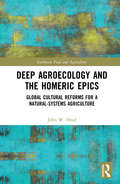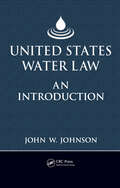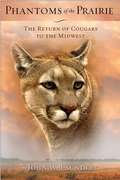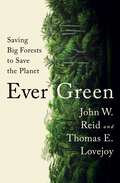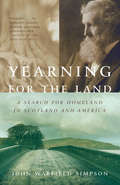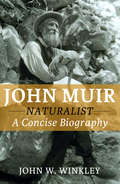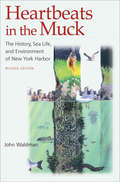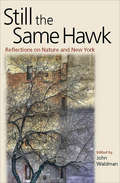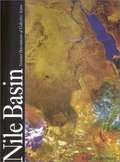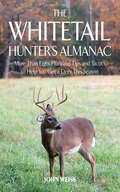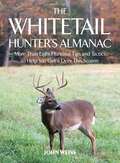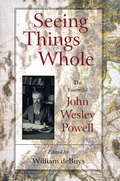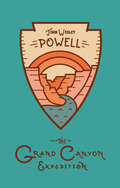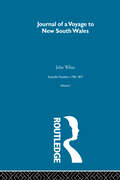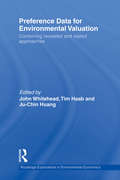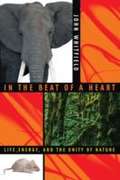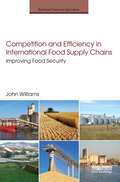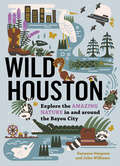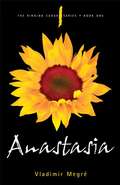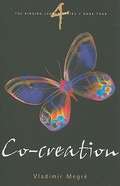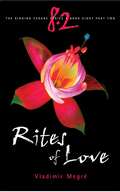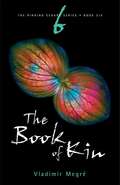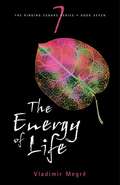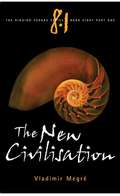- Table View
- List View
Deep Agroecology and the Homeric Epics: Global Cultural Reforms for a Natural-Systems Agriculture (Earthscan Food and Agriculture)
by John W. HeadDrawing on the Homeric epics, this multidisciplinary work reveals the cultural transformations which need to take place in order to transition from today’s modern extractive agricultural system to a sustainable natural‐systems agriculture. In order to provide an imaginative foundation on which to build such a cultural transformation, the author draws on the oldest and most pervasive pair of literary works in the Western canon: the Iliad and the Odyssey. He uses themes from those foundational literary works to critique the concept of state sovereignty and to explain how innovative federalism structures around the world already show momentum building toward changes in global environmental governance. The book proposes a dramatic expansion on those innovations, to create eco‐states responsible for agroecological management. Drawing from many years of experience in international institutions, the author proposes a system of coordination by which an international agroecology‐focused organization would simultaneously (i) avoid the shortcomings of the world’s current family of powerful global institutions and (ii) help create and implement a reformed system of local landscape‐based agriculture wholly consistent with ecological principles. Acknowledging the difficulty of achieving reforms such as these, the author suggests that a new cultural‐conceptual narrative can be constructed drawing on values set forth 2,700 years ago in the Homeric epics. He explains how these values can be reimagined to drive forward our efforts in addressing today’s the climate and agricultural crises in ways that reflect, not reject, the natural processes and relationships that make the Earth a living planet. This book will be of great interest to students, academics and policymakers addressing issues of agrarian values, environmental and agricultural law, environmental restoration, agroecology, and global institutional reform.
United States Water Law: An Introduction
by John W. JohnsonA Vital Explanation of Water Law and PolicyBecause demand for and access to quality water far exceeds the current supply, it is increasingly critical to understand the state and federal laws and policies that govern water rights. From farming, fishing, and biology to manufacturing, mine operation, and public water supply, water regulation affects a
Phantoms of the Prairie
by John W. LaundréLast seen in the 1880s, cougars (also known as pumas or mountain lions) are making a return to the plains regions of the Midwest. Their comeback, heralded by wildlife enthusiasts, has brought concern and questions to many. Will the people of the region make room for cougars? Can they survive the highly altered landscape of the Midwest? Is there a future for these intrepid pioneers if they head even farther east? Â Â Â Using GIS technology, and historical data, among many other methods, Phantoms of the Prairie takes readers on a virtual journey, showing how the cougar might move over the landscape with minimal human contact. Drawing on his years of research on cougars, John W. Laundré offers an overview of what has been, what is, and what might be regarding the return of cougars to their ancestral prairie homeland.
Ever Green: Saving Big Forests to Save the Planet
by Thomas E. Lovejoy John W. ReidClear, provocative, and persuasive, Ever Green is an inspiring call to action to conserve Earth’s irreplaceable wild woods, counteract climate change, and save the planet. Five stunningly large forests remain on Earth: the Taiga, extending from the Pacific Ocean across all of Russia and far-northern Europe; the North American boreal, ranging from Alaska’s Bering seacoast to Canada’s Atlantic shore; the Amazon, covering almost the entirety of South America’s bulge; the Congo, occupying parts of six nations in Africa’s wet equatorial middle; and the island forest of New Guinea, twice the size of California. These megaforests are vital to preserving global biodiversity, thousands of cultures, and a stable climate, as economist John W. Reid and celebrated biologist Thomas E. Lovejoy argue convincingly in Ever Green. Megaforests serve an essential role in decarbonizing the atmosphere—the boreal alone holds 1.8 trillion metric tons of carbon in its deep soils and peat layers, 190 years’ worth of global emissions at 2019 levels—and saving them is the most immediate and affordable large-scale solution to our planet’s most formidable ongoing crisis. Reid and Lovejoy offer practical solutions to address the biggest challenges these forests face, from vastly expanding protected areas, to supporting Indigenous forest stewards, to planning smarter road networks. In gorgeous prose that evokes the majesty of these ancient forests along with the people and animals who inhabit them, Reid and Lovejoy take us on an exhilarating global journey.
Yearning for the Land: A Search for the Importance of Place
by John W. SimpsonA beautiful, meditative memoir mixed with travel and history, this unique book is the story of one American's search for a deeper connection to the land. Drawn by a sense that he is missing a critical link to his home in suburban Ohio, John W. Simpson heads for rural Scotland, where he encounters his own family history as well as estate owners and tenant farmers who have centuries-long ties to their land. As he travels, he meditates on the legacy of the great 19th century conservationist John Muir, who himself developed a complex love of the land when he immigrated from Scotland's North Sea coast to the fields and forests of Wisconsin. As Simpson physically retraces Muir's journey he wonders what sense of belonging Muir found on the frontier that modern America, with its strip malls and housing developments, has forgotten. A fascinating story of changing perceptions and values from the Old World to the New, Yearning for the Land shows us just how much roots matter--both in our own lives, and in the many ways time and history, landscape and community are tightly intertwined.From the Trade Paperback edition.
John Muir: A Concise Biography of the Great Naturalist
by John W. WinkleyJohn Muir, Naturalist, first published in 1959, is an account of the life of John Muir (1838-1914) an early advocate of nature preservation. From his childhood in Scotland and the family’s move to Wisconsin, the book describes Muir’s early influences and his love of nature. After a time at the University of Wisconsin-Madison, and working in Indiana, Muir set off—on foot—to the Gulf of Mexico, and eventually ended in California, devoting time to the preservation of Yosemite and the western forests. In later life, Muir operated a large fruit farm in Martinez, California, while writing 12 books and over 300 articles, and co-founding the conservation organization the Sierra Club. Included are 6 pages of illustrations.
Heartbeats in the Muck: The History, Sea Life, and Environment of New York Harbor, Revised Edition
by John WaldmanHeartbeats in the Muck traces the incredible arc of New York Harbor’s environmental history. Once a pristine estuary bristling with oysters and striped bass and visited by sharks, porpoises, and seals, the harbor has been marked by centuries of rampant industrialization and degradation of its natural environment. Garbage dumping, oil spills, sewage sludge, pesticides, heavy metals, poisonous PCBs, landfills, and dredging greatly diminished life in the harbor, in some places to nil. Now, forty years after the Clean Water Act began to resurrect New York Harbor, John Waldman delivers a new edition of his New York Society Library Award–winning book. Heartbeats in the Muck is a lively, accessible narrative of the animals, water quality, and habitats of the harbor. It includes captivating personal accounts of the author’s explorations of its farthest and most noteworthy reaches, treating readers to an intimate environmental tour of a shad camp near the George Washington Bridge, the Arthur Kill (home of the resurgent heron colonies), the Hackensack Meadowlands, the darkness under a giant Manhattan pier, and the famously polluted Gowanus Canal. A new epilogue details some of the remarkable changes that have come upon New York Harbor in recent years. Waldman’s prognosis is a good one: Ultimately, environmental awareness and action has allowed the harbor to begin cleaning itself. Although it will never regain its native biological glory, the return of oysters, herons, and a host of other creatures is an indication of New York Harbor’s rebirth. This excellent, engaging introduction to the ecological issues surrounding New York Harbor will appeal to students and general readers alike. Heartbeats in the Muck is a must-read for anyone who likes probing the wilds, whether country or city, and natural history books such as Beautiful Swimmers and Mannahatta.
Still the Same Hawk: Reflections on Nature and New York
by John WaldmanThis essay collection draws on natural history, urban ecology, and environmental politics to consider New York City&’s complex relationship to nature. How can a hawk nesting above Fifth Avenue become a citywide phenomenon? Why does a sudden butterfly migration at Coney Island energize the community? What makes the presence of a community garden or an empty lot ripple so differently through the surrounding neighborhood? Is the city an oasis or a desert for biodiversity? Does nature even matter to New Yorkers, who choose to live in a concrete jungle? Still the Same Hawk examines these questions with a rich mix of creative nonfiction that ranges from analytical to anecdotal and humorous. John Waldman&’s sharp, well-crafted introduction presenting dualism as the defining quality of urban nature is followed by compelling contributions from Besty McCully, Christopher Meier, Tony Hiss, Kelly McMasters, Dara Ross, William Kornblum, Phillip Lopate, David Rosane, Robert Sullivan, Anne Matthews, Devin Zuber, and Frederick Buell. Together these pieces capture a wide range of viewpoints, including the myriad and shifting ways New Yorkers experience and consider the outdoors, the historical role of nature in shaping New York&’s development, what natural attributes contribute to New York&’s regional identity, the many environmental tradeoffs made by urbanization, and even nature&’s dark side where &“urban legends&” flourish.
The Nile Basin: National Determinants of Collective Action
by John WaterburyJohn Waterbury applies collective action theory and international relations theory to the challenges of the ten Nile nations.
The Whitetail Hunter's Almanac: More Than 800 Tips and Tactics to Help You Get a D (Lyons Press Ser.)
by John WeissTo take the most impressive whitetail bucks, and to bring them in consistently, a hunter has to know his weapons, the woods, and most of all, his quarry. Now, with The Whitetail Hunter's Almanac at your side, you too can hunt with the strategies and practical wisdom that master hunter John Weiss has learned during his thirty-plus years on the field. Drawing on years of insider research, data studies, and personal experience, Weiss reveals the never-fail methods to making your shots count.Weiss's expert whitetail hunting secrets include:Little-known facts about whitetailsThe perfect places to set up blinds and standsEffective ways to use deer scentsDisappearing with camouflageHunting with a rifle, shogun, or bowAnd much more!With careful instructions and over two hundred photographs to bring the hunt to you, The Whitetail Hunter's Almanac is the must-have reference to make you a better tracker, a craftier woodsman, and a more consistently successful whitetail hunter. If you love the thrill of taking down a majestic buck, The Whitetail Hunter's Almanac is the guide for you!
The Whitetail Hunter's Almanac: More Than 800 Tips and Tactics to Help You Get a Deer This Season (Lyons Press Ser.)
by John Weiss Peter FiducciaTo take the most impressive whitetail bucks, and to bring them in consistently, a hunter has to know his weapons, the woods and, most of all, his quarry. Now, with The Whitetail Hunter’s Almanac at your side, you too can hunt with the strategies and practical wisdom that master hunter John Weiss has learned during his thirty-plus years on the field. Drawing on years of insider research, data studies, and personal experience, Weiss reveals the never-fail methods to making your shots count.Weiss’s expert whitetail hunting secrets include: Little-known facts about whitetails The perfect places to set up blinds and stands Effective ways to use deer scents How to disappear with camouflage Hunting with a rifle, shotgun, or bow And much more!With careful instructions and more than two hundred photographs to bring the hunt to you, The Whitetail Hunter’s Almanac is the must-have reference to make you a more efficient tracker, woodsman, and consistently successful whitetail hunter. If you love the thrill of outwitting a big buck, The Whitetail Hunter’s Almanac is the guide for you!
Seeing Things Whole: The Essential John Wesley Powell (Pioneers of Conservation)
by John Wesley Powell William DebuysJohn Wesley Powell was an American original. He was the last of the nation's great continental explorers and the first of a new breed of public servant: part scientist, part social reformer, part institution builder. His work and life reveal an enduringly valuable way of thinking about land, water, and society as parts of an interconnected whole; he was America's first great bioregional thinker.Seeing Things Whole presents John Wesley Powell in the full diversity of his achievements and interests, bringing together in a single volume writings ranging from his gripping account of exploring the Colorado River through the Grand Canyon to his views on the evolution of civilization, along with the seminal writings in which he sets forth his ideas on western settlement and the allocation and management of western resources.The centerpiece of Seeing Things Whole is a series of selections from the famous 1878 Report on the Lands of the Arid Region and related magazine articles in which Powell further develops the themes of the report. John Wesley Powell's bioregional vision remains a model for governance that many westerners see as a viable solution to the resource management conflicts that continue to plague the region.Throughout the collection, award-winning writer and historian William deBuys brilliantly sets the historical context for Powell's work. Section introductions and extensive descriptive notes take the reader through the evolution of John Wesley Powell's interests and ideas from his critique of Social Darwinism and landmark categorization of Indian languages to the climactic yet ultimately futile battles he fought to win adoption of his land-use proposals.Seeing Things Whole presents the essence of the extraordinary legacy that John Wesley Powell has left to the American people, and to people everywhere who strive to reconcile the demands of society with the imperatives of the land.
The Grand Canyon Expedition: The Exploration Of The Colorado River And Its Canyons
by John Wesley PowellThe geologist and explorer’s own account of his perilous venture into one of the last unmapped portions of the continental United States.Join John Wesley Powell’s expedition to explore one of the Seven Wonders of the Natural World, and one of the last unmapped portions of the continental United States. Powell’s detailed descriptions of the rocks, plants, and animals seen in the canyon; the geography of the area; his team’s interactions with native groups; and dangers and mishaps along the trail allow readers to feel the thrill, the awe, and the humility of standing on the canyon’s edge.After losing an arm in the Civil War, the young Powell took on an extraordinary challenge as he led a small team into this remarkable landscape. He would go on to become the director of the US Geological Survey and the Smithsonian, and is acknowledged today for his foresight on the importance of conserving natural resources—particularly water—as the nation rapidly expanded westward.“Powell’s ideas powerfully shaped development of the West’s water supply.” —Scientific American “He had entered the Grand Canyon as a pioneer, hoping that it could be exploited and settled, but the experience changed him. He realized that the presence of indigenous peoples, the landscape, water and ecosystems meant that it could not and should not be settled as the Eastern states had been. Now, as the Western states are threatened with a catastrophic water shortage, it is possible that he should be remembered not just as an explorer, but also as a prophet.” —BBC News Magazine
Journal of a Voyage to New South Wales: Scientific Travellers 1790-1877 Volume 1
by John WhiteThere have always been more or less scientific travellers, but a new epoch began with the voyages of Captain James Cook. His first, on board the converted Whitby Collier HMS Endeavour, was the result of cooperation between the Admiralty and the Royal Society. This series only skims the surface of the rich collections of scientific travel books in the library of the Natural History Museum. From this volume we learn much about the voyage of the first fleet, the first desperate years of the colony in Sydney, and the exploration of its neighbourhood.
Preference Data for Environmental Valuation: Combining Revealed and Stated Approaches (Routledge Explorations In Environmental Economics Ser. #31)
by John Whitehead Tim Haab Ju-Chin HuangThe monetary valuation of environmental goods and services has evolved from a fringe field of study in the late 1970s and early 1980s to a primary focus of environmental economists over the past decade. Despite its rapid growth, practitioners of valuation techniques often find themselves defending their practices to both users of the results of applied studies and, perhaps more troubling, to other practitioners. One of the more heated threads of this internal debate over valuation techniques revolves around the types of data to use in performing a valuation study. In the infant years of the development of valuation techniques, two schools of thought emerged: the revealed preference school and the stated preference school, the latter of which is perhaps most associated with the contingent valuation method. In the midst of this debate an exciting new approach to non-market valuation was developed in the 1990s: a combination and joint estimation of revealed preference and stated preference data. There are two primary objectives for this book. One objective is to fill a gap in the nonmarket valuation "primer" literature. A number of books have appeared over the past decade that develop the theory and methods of nonmarket valuation but each takes an individual nonmarket valuation method approach. This book considers each of these valuation methods in combination with another method. These relationships can be exploited econometrically to obtain more valid and reliable estimates of willingness-to-pay relative to the individual methods. The second objective is to showcase recent and novel applications of data combination and joint estimation via a set of original, state-of-the-art studies that are contributed by leading researchers in the field. This book will be accessible to economists and consultants working in business or government, as well as an invaluable resource for researchers and students alike.
In The Beat Of A Heart: Life, Energy, And The Unity Of Nature
by John WhitfieldFor centuries, scientists have dreamt of discovering an underlying unity to nature. Science now offers powerful explanations for both the dazzling diversity and striking similarities seen in the living world. Life is complicated. It is truly the “entangled bank” that Charles Darwin described. But scientists are now discovering that energy is the unifying force that joins all life on Earth. Visionary biologists have advanced a new theory that explains how the natural world—from the tiniest amoeba to the greatest rain forest—is constructed, providing a fresh perspective on the essential interconnectivity of living systems. This revolutionary theory explains a variety of phenomena—helping us understand why a shrew eats its bodyweight in food each day, why a mammal’s heart beats about 1 billion times in its lifetime, why there are no trees as tall as the Eiffel Tower, and why more species live at the Earth’s equator than at its poles. By looking at how living things use energy, we can answer these and myriad other intriguing questions. In the Beat of a Heart combines biography, history, science and nature writing to capture the exciting advances— and the people who are making them—that are triggering a revolution as potentially important to biology as Newton’s insights were to physics.
Competition and Efficiency in International Food Supply Chains: Improving Food Security (Earthscan Food and Agriculture)
by John WilliamsWhy have food crises seemingly become more frequent in recent years, compared to the last few decades? This book examines an array of different issues and distortions that are causing food supply chain dysfunction in many countries, particularly for staple non-perishable foods such as grains, oilseeds, pulses and sugar. It outlines the underlying changes that are currently occurring, which will have an influence on the direction of future food supply chains, and provides some solutions to current food security problems. Based on an analysis of total regulation in the 1950s-60s through to deregulation during the 1980-90s, as well as post-deregulation, it focuses on liberal trade and deregulation as a more successful solution to creating efficiencies in food supply chains and distribution. The author highlights a common thread of either farmers using government for vested-interest intervention, or autocratic governments seeking market and supply-chain power. The book examines the role of government after 70 years of food supply chain intervention. It discusses the role of commercial ‘trade’ markets and cluster industries and how these can quickly disintegrate when price distortions occur. The author studies both food importing and exporting countries and concludes that comingled commoditization of food has led to increased hoarding, corruption, and dependence on food aid. He argues that a competitive food supply chain that has minimum intervention is more likely to provide future food security. In conclusion the book emphasizes that adequate rewards, competition, and striving for supply chain efficiencies are the essences of sustainable food security.
Wild Houston: Explore the Amazing Nature in and around the Bayou City
by John Williams Suzanne SimpsonThis vibrant, informative guide shows the unexpected and amazing nature in Houston and the surrounding area just waiting to be explored. Houston is more than just a bustling metroplex, it's full of amazing wildlife. You just need to know where to find it! Equal parts natural history, field guide, and trip planner, Wild Houston has something for everyone. This handy yet extensive guide looks at the factors that shape local nature and profiles over 100 local species, from the Barred Owl and the Western Rat Snake to the Houston Burrowing Crayfish, the Rainbow Scareb, and the Nine-banded Armadillo. Also included are descriptions of day trips that help you explore natural wonders on hiking trails, in public parks, and in your own backyard.
Hope and Courage in the Climate Crisis: Wisdom and Action in the Long Emergency
by John WisemanAs the risks of the climate crisis continue to grow, so too do the challenges of facing a harsh climate future with honesty and courage; justice and compassion; meaning and purpose. Hope and Courage in the Climate Crisis explores diverse sources of learning and wisdom –from climate scientists and activists; philosophers and social theorists; Indigenous cultures and ways of life; faith based and spiritual traditions; artists and writers –which can help us live courageous, compassionate and creative lives in a world of rapidly accelerating climatic and ecological risk.Accelerating the transition to a just and resilient zero-carbon society will require visionary leadership and courageous collective action. Awareness that rapid action might still be insufficient to prevent severe and irreversible social and ecological damage is however a source of deep concern for many people passionately committed to decisive climate action. Drawing on broad experience as a climate activist, researcher and policy maker John Wiseman provides a wide ranging, accessible and provocative guided tour of ideas which can inspire and sustain radical hope and defiant courage in the long emergency which now lies before us.
Anastasia (The Ringing Cedars Series #1)
by Vladimir Megré John Woodsworth Leonid SharashkinYou are about to read some of the most shocking revelations to appear in thousands of years of human history - so significant that they are changing the course of our destiny and rocking scientific and religious circles to the core.
Co-creation (The Ringing Cedars Series #4)
by Vladimir Megré John Woodsworth Leonid SharashkinIf you wish to gain as full an appreciation as possible of the ideas, thoughts and images set forth here, as well as experience the benefits that come with this appreciation, we recommend you find a quiet place for your reading where there is the least possible interference from artificial noises (motor traffic, radio, TV, household appliances etc.). Natural sounds, on the other hand -- the singing of birds, for example, or the patter of rain, or the rustle of leaves on nearby trees -- maybe a welcome accompaniment to the reading process.
Rites of Love (The Ringing Cedars Series #8, Part #2)
by Vladimir Megré John Woodsworth Leonid SharashkinThis book is a call to research, to becoming aware of the Divine programme.
The Book of Kin (The Ringing Cedars Series #6)
by Vladimir Megré John Woodsworth Leonid SharashkinAnastasia has shown that there exists in Nature some kind of mechanism, some kind of higher power capable of solving a seemingly insoluble problem in an instant. Through a couple's -- a man and a woman's -- specific mental state, this mechanism or power will help them find the conditions and techniques of sexual intercourse appropriate solely to them.
The Energy of Life (The Ringing Cedars Series #7)
by Vladimir Megré John Woodsworth Leonid SharashkinMan's life! On what or on whom does it depend? Why do some become emperors or regimental commanders, while others are obliged to fend for scraps at garbage dumps? One opinion holds that each person's fate is pre-determined from birth. That would make Man nothing more than an insignificant cog in some mechanised system, and not the highly organised creation of God.
The New Civilisation (The Ringing Cedars Series #8, Part #1)
by Vladimir Megré John Woodsworth Leonid Sharashkin"The New Civilisation" is Book 8 Part 1 of The Ringing Cedars Book Series. This series of nine books tells the story of a remarkable woman named Anastasia, discovered in 1995 by a Siberian trader, Vladimir Megré, while he was plying the waters of the remote Ob River. Anastasia was born in the forest in 1969 to parents who died tragically when she was just a baby. Living for the most part without warm clothes, food cultivation or man-made shelter, she has survived on fruit, nuts, berries and mushrooms, brought to her by "wild" animals with which she lives in peaceful harmony. Megré initially spent three days with Anastasia, during which time she displayed such astounding knowledge, power and wisdom that he abandoned his business and, at her request, began writing this series. She told him she would encode the books with an energy that would cause them to sell in the millions. Despite his lack of writing experience, this is exactly what happened. It is Anastasia's ability to strike a chord in the heart of the reader that makes these books so very unusual. The purity and power of her words is provoking an outpouring of joy and hope in people from all walks of life.
